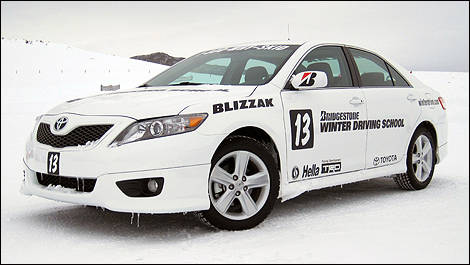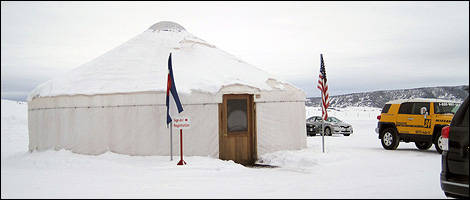STEAMBOAT SPRINGS, Colorado – Seven thousand feet above sea level, the air is crisp, dry and clear enough to see across the entire Yampa Valley.
The legendary "Sleeping Giant" (also known as Elk Mountain) looms over us, a majestic and benevolent presence.
I'm heading downhill toward a blind, off-camber turn on sheer ice in a Toyota Camry. What sounds like a recipe for disaster finishes in a neatly executed exercise – thanks to the skills I've acquired through the Bridgestone Winter Driving School.
Established twenty-eight years ago, the school is located two miles outside of Steamboat Springs, a skiing mecca that boasts more Winter Olympians residents than anywhere else in the country. From mid-December to early March, participants of all ability levels can spend a half-day, full day or two days – starting with the fundamentals of safe winter driving, right up to performance-geared classes using techniques practiced by competitive rally drivers.
Bridgestone Winter Driving School’s director, Mark Cox, is a former rally competitor and professional stunt driver and has taught precision driving to FBI agents, law enforcement personnel, professional race drivers and rally drivers. The instructors are equally proficient in a variety of driving disciplines from road racing to rally sport.
Before we head up into the mountains, we must first attend a classroom session outlining the basics of car control.
The most important skill a driver can have is good vision – looking ahead and being aware of surroundings so that he can plan ahead and adjust speed accordingly, instead of reacting in panic.
Regardless of whether it’s a rear-wheel drive sports car, a front-wheel drive sedan or an all-wheel-drive SUV, the most important safety feature of any vehicle is the contact patch – that rectangular section of rubber where the tire meets the road.
All the technology in the world is no substitute for good grip – and only a genuine winter tire (bearing the industry-standard mountain snowflake) can provide sufficient grip when the temperature dips below zero. Forget what you’ve been taught about “all-season tires” (also known as “no-season” tires by professionals). They are, at best, a poor compromise. It’s not just about tread: proper winter tires are created with a compound that remains malleable far below freezing, to provide a sticky, surface-adhering grip. Non-winter tires become hard and unyielding, as “slippery as a hockey puck” according to Bridgestone instructor Lea Croteau.
The legendary "Sleeping Giant" (also known as Elk Mountain) looms over us, a majestic and benevolent presence.
 |
| Bridgestone Winter Driving School cars are supplied by Toyota, a major sponsor of the school. (Photo: Lesley Wimbush/Auto123.com) |
I'm heading downhill toward a blind, off-camber turn on sheer ice in a Toyota Camry. What sounds like a recipe for disaster finishes in a neatly executed exercise – thanks to the skills I've acquired through the Bridgestone Winter Driving School.
Established twenty-eight years ago, the school is located two miles outside of Steamboat Springs, a skiing mecca that boasts more Winter Olympians residents than anywhere else in the country. From mid-December to early March, participants of all ability levels can spend a half-day, full day or two days – starting with the fundamentals of safe winter driving, right up to performance-geared classes using techniques practiced by competitive rally drivers.
Bridgestone Winter Driving School’s director, Mark Cox, is a former rally competitor and professional stunt driver and has taught precision driving to FBI agents, law enforcement personnel, professional race drivers and rally drivers. The instructors are equally proficient in a variety of driving disciplines from road racing to rally sport.
Before we head up into the mountains, we must first attend a classroom session outlining the basics of car control.
The most important skill a driver can have is good vision – looking ahead and being aware of surroundings so that he can plan ahead and adjust speed accordingly, instead of reacting in panic.
Regardless of whether it’s a rear-wheel drive sports car, a front-wheel drive sedan or an all-wheel-drive SUV, the most important safety feature of any vehicle is the contact patch – that rectangular section of rubber where the tire meets the road.
All the technology in the world is no substitute for good grip – and only a genuine winter tire (bearing the industry-standard mountain snowflake) can provide sufficient grip when the temperature dips below zero. Forget what you’ve been taught about “all-season tires” (also known as “no-season” tires by professionals). They are, at best, a poor compromise. It’s not just about tread: proper winter tires are created with a compound that remains malleable far below freezing, to provide a sticky, surface-adhering grip. Non-winter tires become hard and unyielding, as “slippery as a hockey puck” according to Bridgestone instructor Lea Croteau.
 |
| Lunch and mid-day classroom sessions are held in a "yurt", the only building on the site. (Photo: Lesley Wimbush/Auto123.com) |


